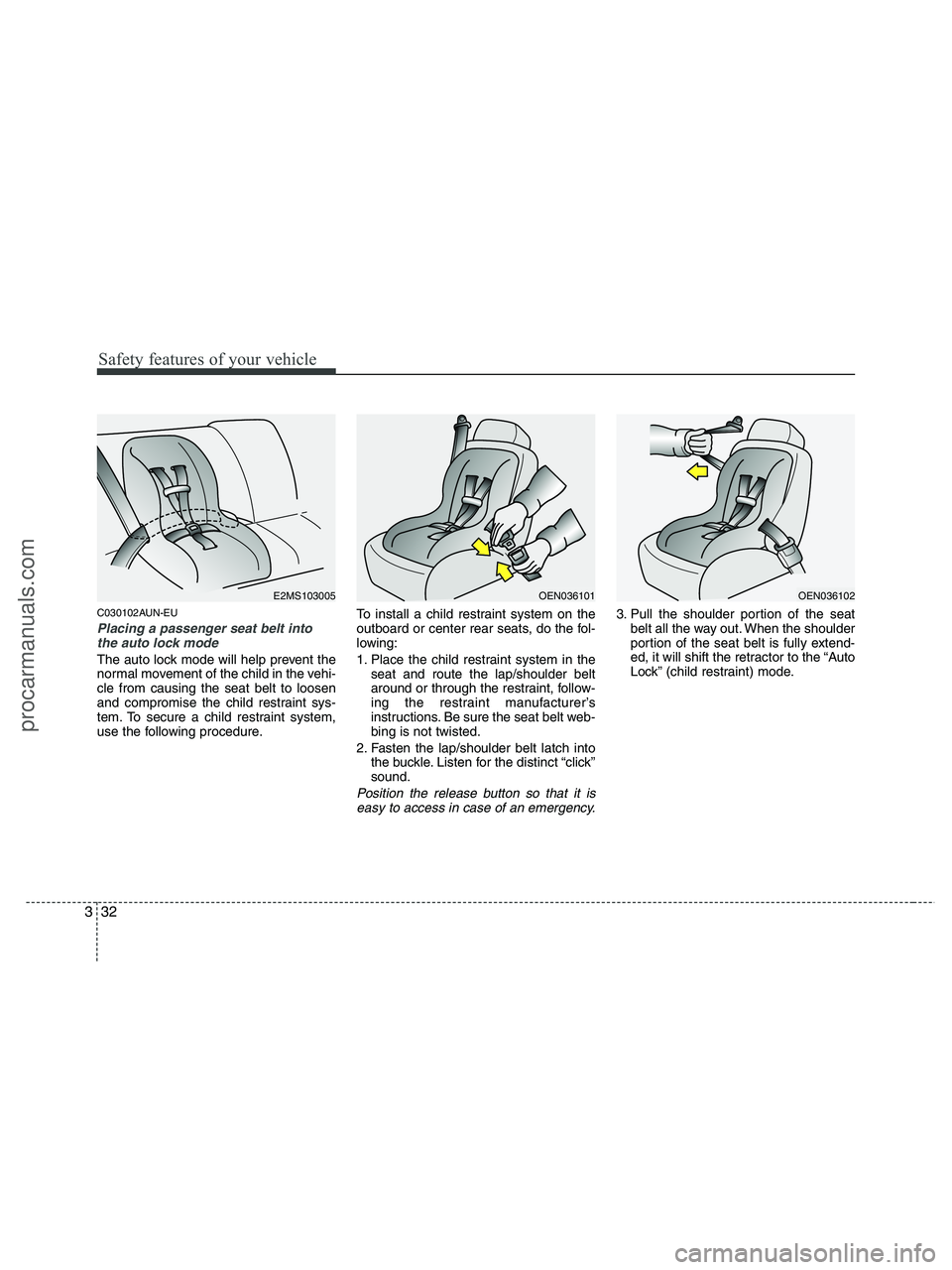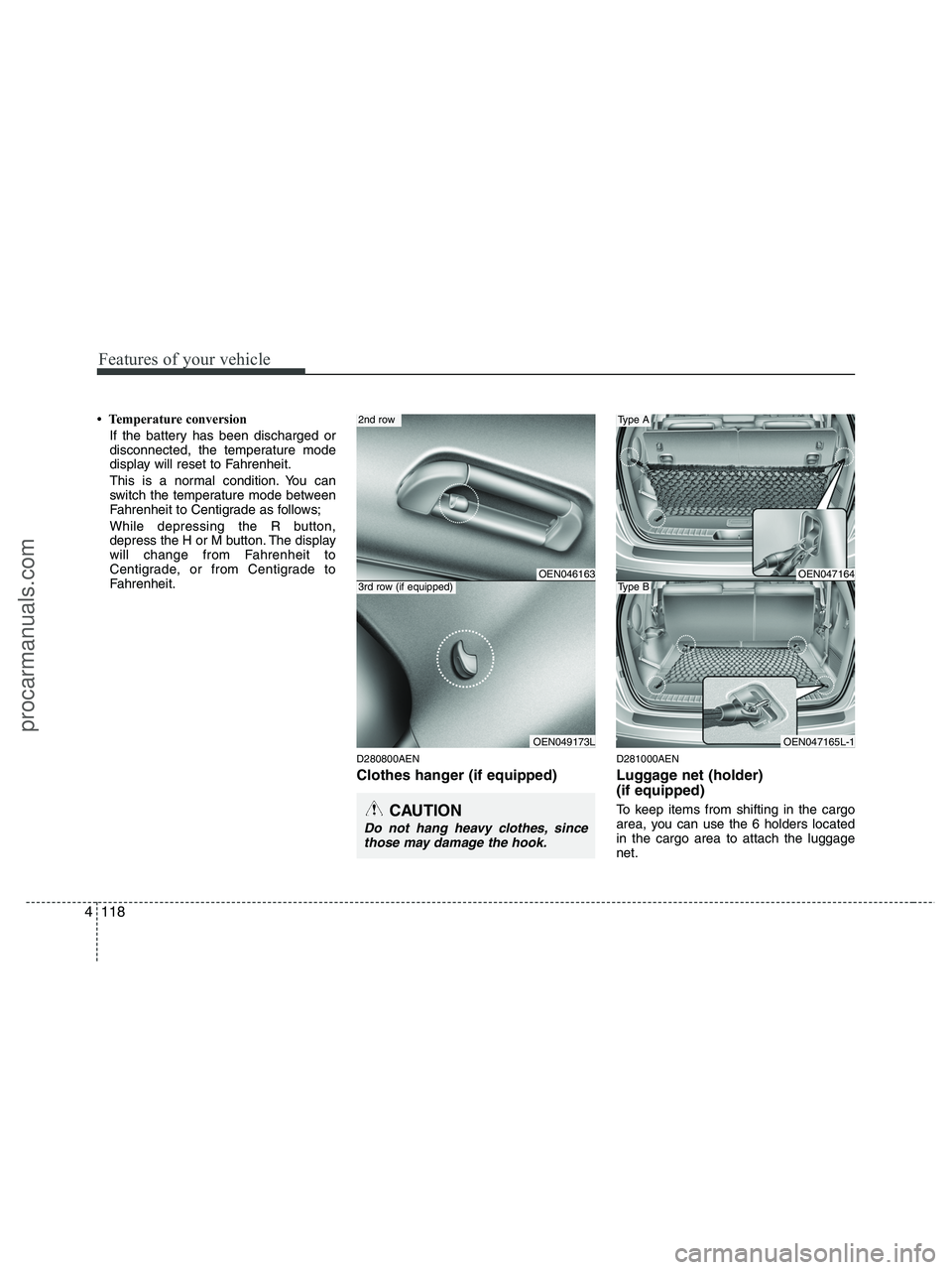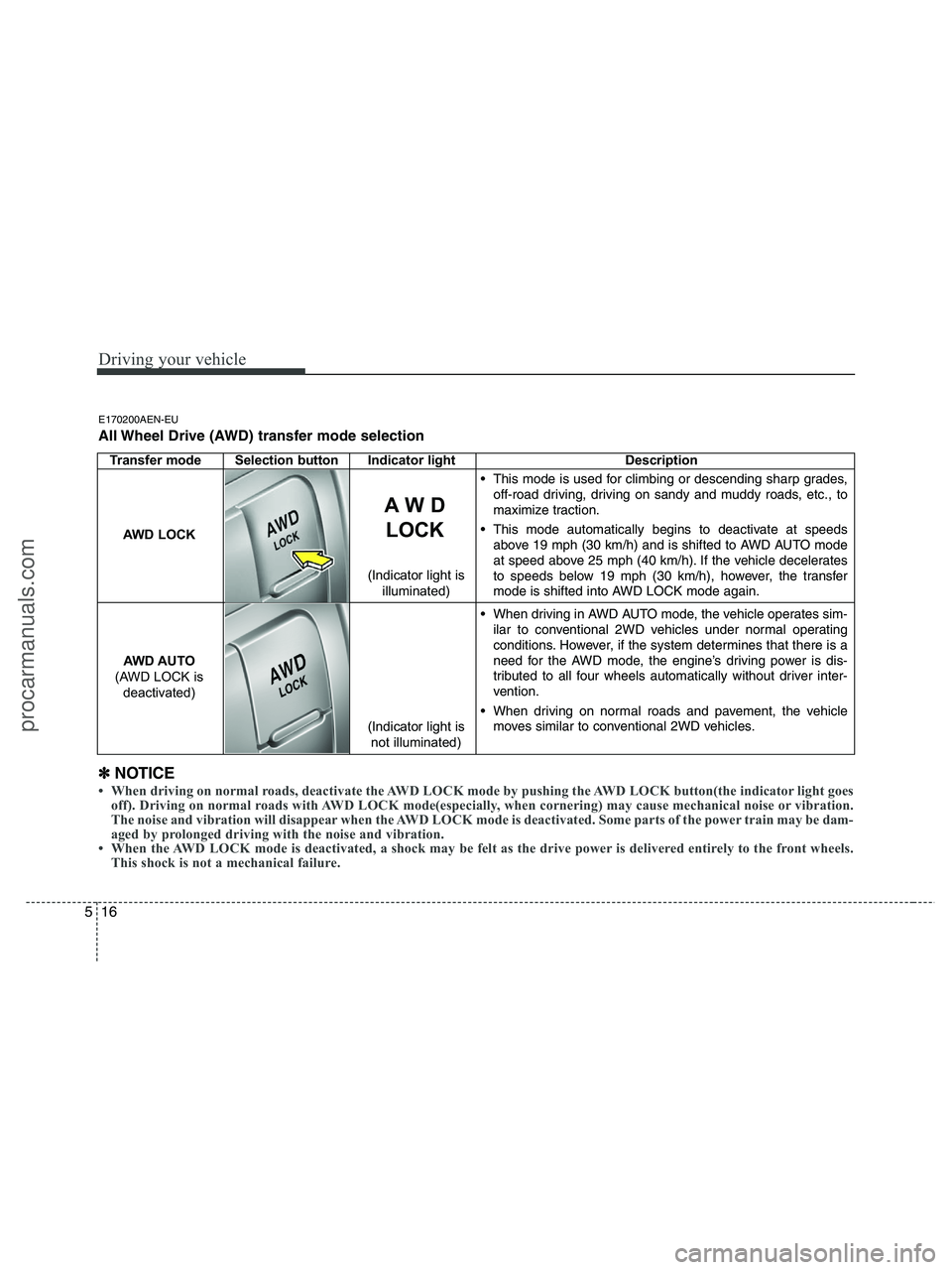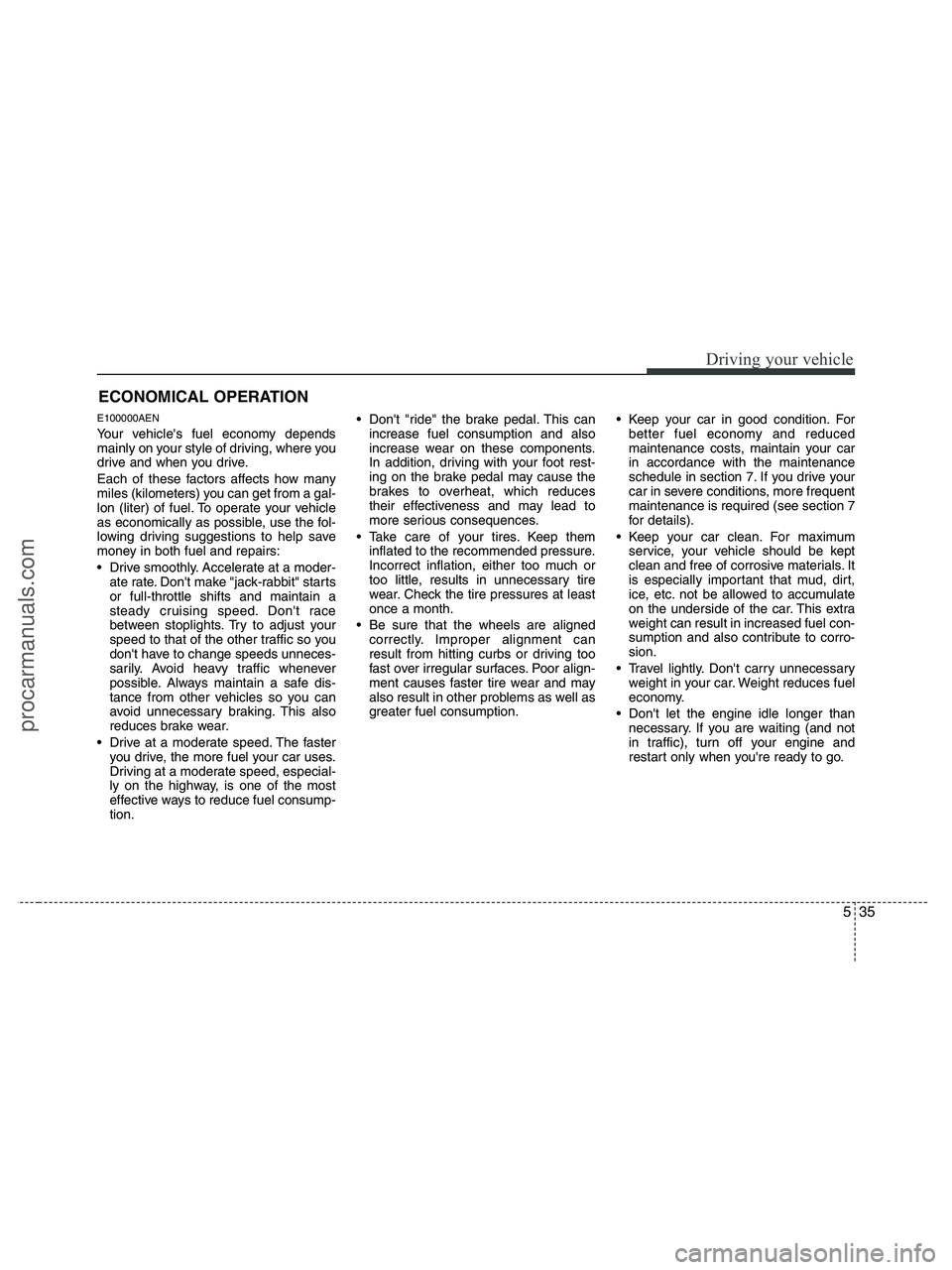2010 HYUNDAI VERACRUZ shift mode
[x] Cancel search: shift modePage 52 of 425

Safety features of your vehicle
32 3
C030102AUN-EU
Placing a passenger seat belt into
the auto lock mode
The auto lock mode will help prevent the
normal movement of the child in the vehi-
cle from causing the seat belt to loosen
and compromise the child restraint sys-
tem. To secure a child restraint system,
use the following procedure.To install a child restraint system on the
outboard or center rear seats, do the fol-
lowing:
1. Place the child restraint system in the
seat and route the lap/shoulder belt
around or through the restraint, follow-
ing the restraint manufacturer’s
instructions. Be sure the seat belt web-
bing is not twisted.
2. Fasten the lap/shoulder belt latch into
the buckle. Listen for the distinct “click”
sound.
Position the release button so that it is
easy to access in case of an emergency.
3. Pull the shoulder portion of the seat
belt all the way out. When the shoulder
portion of the seat belt is fully extend-
ed, it will shift the retractor to the “Auto
Lock” (child restraint) mode.
E2MS103005OEN036102OEN036101
procarmanuals.com
Page 200 of 425

Features of your vehicle
118 4
• Temperature conversion
If the battery has been discharged or
disconnected, the temperature mode
display will reset to Fahrenheit.
This is a normal condition. You can
switch the temperature mode between
Fahrenheit to Centigrade as follows;
While depressing the R button,
depress the H or M button. The display
will change from Fahrenheit to
Centigrade, or from Centigrade to
Fahrenheit.
D280800AEN
Clothes hanger (if equipped)
D281000AEN
Luggage net (holder)
(if equipped)
To keep items from shifting in the cargo
area, you can use the 6 holders located
in the cargo area to attach the luggage
net.CAUTION
Do not hang heavy clothes, since
those may damage the hook.
OEN047164
OEN047165L-1
Type A
Type BOEN046163
OEN049173L
2nd row
3rd row (if equipped)
procarmanuals.com
Page 269 of 425

511
Driving your vehicle
Sports mode
Whether the vehicle is stationary or in
motion, sports mode is selected by push-
ing the shift lever from the D (Drive) posi-
tion into the manual gate. To return to D
(Drive) range operation, push the shift
lever back into the main gate.
In sports mode, moving the shift lever
backwards and forwards will allow you to
make gearshifts rapidly. In contrast to a
manual transaxle, the sports mode
allows gearshifts with the accelerator
pedal depressed.Up (+) : Push the lever forward once to
shift up one gear.
Down (-) : Pull the lever backwards once
to shift down one gear.
✽ ✽
NOTICE
• In sports mode, the driver must exe-
cute upshifts in accordance with road
conditions, taking care to keep the
engine speed below the red zone.
• In sports mode, only the 6 forward
gears can be selected. To reverse or
park the vehicle, move the shift lever
to the R (Reverse) or P (Park) position
as required.
• In sports mode, downshifts are made
automatically when the vehicle slows
down. When the vehicle stops, 1st gear
is automatically selected.
(Continued)(Continued)
• In sports mode, when the engine rpm
approaches the red zone shift points
are varied to upshift automatically.
• To maintain the required levels of
vehicle performance and safety, the
system may not execute certain
gearshifts when the shift lever is oper-
ated.
• When starting from a stopped posi-
tion in slippery conditions, push the
shift lever forward into the +(up) posi-
tion. This causes the transaxle to shift
into the 2nd (or 3rd) gear which will
make it easier to control wheel spin.
Push the shift lever back to the D
(Drive) once the vehicle is moving.
OEN056003 + (UP)
- (DOWN)
Sports mode
procarmanuals.com
Page 274 of 425

Driving your vehicle
16 5
Transfer mode Selection button Indicator light Description
This mode is used for climbing or descending sharp grades,
off-road driving, driving on sandy and muddy roads, etc., to
maximize traction.
This mode automatically begins to deactivate at speeds
above 19 mph (30 km/h) and is shifted to AWD AUTO mode
at speed above 25 mph (40 km/h). If the vehicle decelerates
to speeds below 19 mph (30 km/h), however, the transfer
mode is shifted into AWD LOCK mode again.
When driving in AWD AUTO mode, the vehicle operates sim-
ilar to conventional 2WD vehicles under normal operating
conditions. However, if the system determines that there is a
need for the AWD mode, the engine’s driving power is dis-
tributed to all four wheels automatically without driver inter-
vention.
When driving on normal roads and pavement, the vehicle
moves similar to conventional 2WD vehicles.
AW D
LOCK
AWD LOCK
AWD AUTO
(AWD LOCK is
deactivated)
(Indicator light is
not illuminated) (Indicator light is
illuminated)
✽ ✽
NOTICE
• When driving on normal roads, deactivate the AWD LOCK mode by pushing the AWD LOCK button(the indicator light goes
off). Driving on normal roads with AWD LOCK mode(especially, when cornering) may cause mechanical noise or vibration.
The noise and vibration will disappear when the AWD LOCK mode is deactivated. Some parts of the power train may be dam-
aged by prolonged driving with the noise and vibration.
• When the AWD LOCK mode is deactivated, a shock may be felt as the drive power is delivered entirely to the front wheels.
This shock is not a mechanical failure.
E170200AEN-EU
All Wheel Drive (AWD) transfer mode selection
procarmanuals.com
Page 293 of 425

535
Driving your vehicle
E100000AEN
Your vehicle's fuel economy depends
mainly on your style of driving, where you
drive and when you drive.
Each of these factors affects how many
miles (kilometers) you can get from a gal-
lon (liter) of fuel. To operate your vehicle
as economically as possible, use the fol-
lowing driving suggestions to help save
money in both fuel and repairs:
Drive smoothly. Accelerate at a moder-
ate rate. Don't make "jack-rabbit" starts
or full-throttle shifts and maintain a
steady cruising speed. Don't race
between stoplights. Try to adjust your
speed to that of the other traffic so you
don't have to change speeds unneces-
sarily. Avoid heavy traffic whenever
possible. Always maintain a safe dis-
tance from other vehicles so you can
avoid unnecessary braking. This also
reduces brake wear.
Drive at a moderate speed. The faster
you drive, the more fuel your car uses.
Driving at a moderate speed, especial-
ly on the highway, is one of the most
effective ways to reduce fuel consump-
tion. Don't "ride" the brake pedal. This can
increase fuel consumption and also
increase wear on these components.
In addition, driving with your foot rest-
ing on the brake pedal may cause the
brakes to overheat, which reduces
their effectiveness and may lead to
more serious consequences.
Take care of your tires. Keep them
inflated to the recommended pressure.
Incorrect inflation, either too much or
too little, results in unnecessary tire
wear. Check the tire pressures at least
once a month.
Be sure that the wheels are aligned
correctly. Improper alignment can
result from hitting curbs or driving too
fast over irregular surfaces. Poor align-
ment causes faster tire wear and may
also result in other problems as well as
greater fuel consumption. Keep your car in good condition. For
better fuel economy and reduced
maintenance costs, maintain your car
in accordance with the maintenance
schedule in section 7. If you drive your
car in severe conditions, more frequent
maintenance is required (see section 7
for details).
Keep your car clean. For maximum
service, your vehicle should be kept
clean and free of corrosive materials. It
is especially important that mud, dirt,
ice, etc. not be allowed to accumulate
on the underside of the car. This extra
weight can result in increased fuel con-
sumption and also contribute to corro-
sion.
Travel lightly. Don't carry unnecessary
weight in your car. Weight reduces fuel
economy.
Don't let the engine idle longer than
necessary. If you are waiting (and not
in traffic), turn off your engine and
restart only when you're ready to go.
ECONOMICAL OPERATION
procarmanuals.com
Page 420 of 425

Index
2I
Air bags-advanced supplemental restraint system ········3-37
Air bag warning label ··················································3-62
Air bag warning light ··················································3-40
Curtain air bag ·····························································3-54
Driver's and passenger's front air bag··························3-48
Occupant classification system ···································3-43
Side impact air bag ······················································3-52
Air cleaner ·····································································7-21
All wheel drive (AWD)··················································5-14
Appearance care·····························································7-59
Exterior care ································································7-59
Interior care ·································································7-64
Audio system ·······························································4-120
Antenna······································································4-120
Steering wheel audio control ·····································4-121
Automatic climate control system ·································4-96
Air conditioning ························································4-102
Automatic heating and air conditioning ······················4-97
Manual heating and air conditioning···························4-98
Rear heating and air conditioning ·····························4-103
Automatic transaxle ·························································5-8
Ignition key interlock system ······································5-12
Shift lock system ·························································5-12
Sports mode ·································································5-11Battery············································································7-27
Before driving ··································································5-3
Brake system··································································5-21
Anti-lock brake system (ABS) ····································5-24
Electronic stability control (ESC) ·······························5-26
Parking brake ·······························································5-22
Power brakes································································5-21
Brakes fluid····································································7-18
Bulb wattage ····································································8-2
California Perchlorate Notice ······································· 7-68
Child restraint system ····················································3-29
Placing a passenger seat belt into
the auto lock mode ···················································3-32
Securing a child restraint seat with
tether anchor system·················································3-34
Securing a child restraint seat with
child seat lower anchor system ································3-35
Climate control air filter ················································7-22
Consumer information ·····················································8-8
Cruise control system ····················································5-31
Defroster ········································································4-83
Dimensions ······································································8-2
Door locks······································································4-14
AB
C
D
procarmanuals.com